The Newhouse Story Founding of the Ultra Van Club
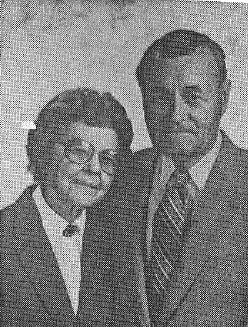
By W. Christy Barden, continuous club member and Ultra Van owner since 1973, UV #228 & UV #603. Past president of Group Ultra Van, 1983-1986 and newsletter editor of WOW from the first edition in 1983 through to mid-2000.
Editor note:
Ernest J. Newhouse is one of our most prominent ULTRA Van people. His energy sparked the start of the ULTRA Van Club way back in 1966. Because he is so widely known, I thought it would be nice to know a little about he and Edna. We had an opportunity to sit down and talk awhile back and this article is a result of that meeting.
This story starts in Norway with Ernest’s grandfather coming from Norway to Minnesota and settling in the southern part of the state. He established a farm near Springrove. He changed his name from Nyhus to Newhouse because he wanted to become and American and be part of the new society. Besides farming, he also bought wild hourses from Montana, trained them and sold them to settler in Northern Minnesota for work horses. He bought (or possibly traded horses for) property in the Northern Minnesota Red River Valley area. Later, he sold that property to his four sons, one of which was Ernie’s father.
Ernie was born in Crookston, Minnesota in a small pioneer house. He and his younger brother helped his father work on the farm. Edna was also born in Crookton of German parents.
Ernie attended Northwest School of Agriculture, a branch of the University of Minnesota and graduated in 1928. This is where he learned about tractors, engines and automotive information. This is also about the time he met Edna who was still in high school.
In 1930, Ernie obtained a scholarship to Carlton College in Northfield, Minnesota, just south of Minneapolis. His father helped with college by going to the Scandi-American bank in Crookton and taking out a loan. Ernest remembers this visit well. The banker asked his father questions like, “how much property and equipment do you own?”, etc. Even though his father was known by many, no one had money at that time during the depression. Ernest remembers feeling remorse while sitting and watching the banker interview his father. The remorse was felt because of having his father incur this debt just to help him go to college. It was the scholarship that really helped, for without it he would have never gone to Carlton.
Ernest had the same problem that most of us have had, what to be in life. He had considered law, medicine and business. He had taken course in each area, but it was his encounter with another student that finally steered him into his final direction. The encounter was with a man named Renaldo, who parents founded the Link Belt Company. He and Ernie talked quite a lot after graduation. Renaldo was going to work in his fathers company. After much thought, Ernie realized that business was going to be his direction as well, so he majored in business administration.
After Carlton, jobs were hard to get. For awhile, Ernie worked at radio station KGFK in Moorehead, Minn. He had gained experience in radio at Carlton because it had a college radio station. As program director he also worked as a D.J. and did the news programs. Edna worked at a bank in Handrum, Minnesota (30 miles north) at the time. She remembers coming home for lunch so she could hear Ernie’s afternoon newscast.
Ernie wanting a job of more permanent nature, went to Minneapolis St. Paul. There he went to work as a sales man selling General Electric appliances. Then up to Duluth selling GE appliances for Kelly-Duluth Hardware store. It was during this time he and Edna decided to get married. The year was 1934. At Ernie’s request, the company gave him a territory in St. Paul. He wanted to settle there because of his recent marriage. He went to work for Premier Electric Company the local GE distributor. He did quite well working wholesale accounts like Bourgon-Powers Furniture store and Shuman and Mainheimers (forerunner of Dayton Dept. stores), as well as direct retail accounts. Edna demonstrated GE vacuum cleaners, small radios and appliances for a short while at Shuman and Mainheimers. During this time, Ernie also knew how to repair appliances if need be.
The operation get bigger with Ernie having to hire five or six salesmen to work for him. The prospering Newhouse’s took a motor trip to California. They also took Edna’s parents and younger brother with them. They were very impressed with the west coast and this would play a big part in their later lives. They built a spanish style home in St. Paul, one block from Lake Como. They also had it paid for before the start of World War II.
When they war came, Ernest volunteered and was sent as an instructor to Chanute Air Field at Rantoul, Illinois. He taught one week cram course to recruits in basic aircraft electricity. 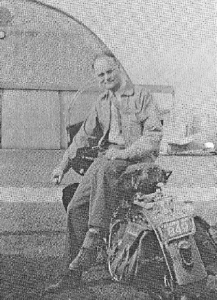
ERNIE RODE HIS MOTORCYCLE TO THE AIRPORT AT RATOUL, IL
He also got his private pilots license at the time. Many people came through schools at Chanute Air Field needing transportation and because of the need, Ernie opened a used car lot across from the base. He bought cars at auctions fixing them up himself and selling them. He was open in the afternoons and evenings. Ernie and Edna sold their house in St. Paul at this time.
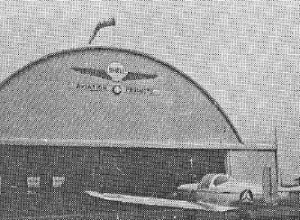
AEROCOUPE THAT ERNIE FLEW DURING THE WAR AT RAUTOL, IL
In January 1945 they drove a 1941 Chevy to San Diego with the intent of settling in California. Ernie had an uncle who lived in North Hollywood. They stayed with the uncle for a few days until a motel vacancy was available. Housing was tight in Southern California after the war. They bought a furnished house in Pico Rivera, a Los Angeles suburb, paying cash. They started buying and fixing houses selling them furnished. This practice became popular in the 1960’s in Southern California. So, once again Ernie was a pioneer. Eventually, both Ernie and Edna got their real estate licenses.
One very important Sunday, Ernie and Edna were out on a drive with his uncle in Griffith Park area of Los Angeles. A funny looking car passed them with no fenders, top or hood. His uncle said, “look there goes a Hot Rod.” Ernie had never heard that word, Hot Rod, before. He was really fascinated with this concept of modifying stock automobiles for track and street use.
Henry Ford was responsible for much of “Hot Rodding” with Model T’s. In California every young person who could get a “T” in the 30’s, would “Hop it up.” I remember reading of Bob Estes’s famous drag race down Santa Monica Boulevard in his hopped-up Model T with Clark Gable in his Packard Speedster. Gable lost in both directions!
Ernest figured, that if this was new to him, then it would be new to a lot of other people. He decided to write a book on Hot Rods and “hopping up” your car. This was before Hot Rod magazine and other such publications. He had a lot of learning to do. He visited dual manifold and high performance parts manufacturers like, Edelbrock, Weiand, Clark and Eddie Edmond’s, learning about porting a relieving the heads, high lift cams, etc. He had been through engineering courses at Northwestern School of Agriculture. He had also rebuilt tractor engines, so he understood the new Hot Rod concepts. He did write the book and it sold one million copies thru adds in Popular Mechanics and other sports magazines. So, it was a Sunday drive that started Newhouse Automotive.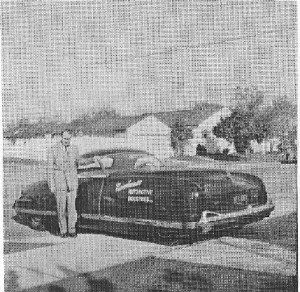
ERNIE STANDING BY HIS CHRYSLER “THUNDERBOLT” BUILT FOR JOE LEWIS AFTER THE WAR
At the time they were between houses, living in an apartment. Edna typed the manuscript and they were both selling real estate.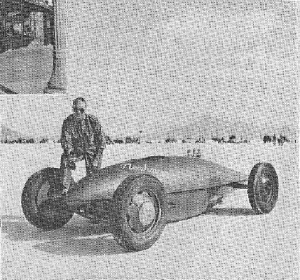
“NEWHOUSE SPECIAL” WITH ERNIE AT BONNEVILLE IN 1952-1953
After the book was published, he started getting letters of inquiry as to where to get the products he discussed in his book. Ernie again realized that it was easy to get parts in Southern California, but in Minnesota or New York no one had ever heard of them. So Ernie decided to get together a small catalog listing the items, and that is how his mail order business started. Business went so well, they had to move out of their garage and took a small store in a new seven store complex on the corner of Gearhart and Beverly Blvd., in Montebello (L.A. area). From this humble beginning, Ernie wound up taking over the other six store area. These stores became a retail parts business, Newhouse Automotive, Pacific Lubricants, Moley Oil Distributor, Engine Accessories and Mfg. Co who made parts for the retail and catalog business and Engine Products Mfg, Co.
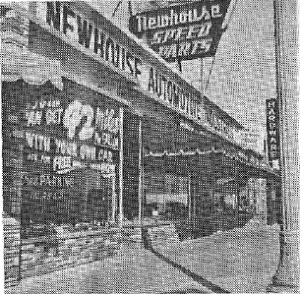
NEWHOUSE AUTOMOTIVE STORE FRONT IN THE LOS ANGELES AREA
By 1961, Ernest has sold Newhouse Automotive to an East coast businessman who wanted to move to California. He also sold Pacific lubricants and Engine Accessories and Mfg. Co. to John Beech, who at the time was the sales manger. Ernest “retired” to manage his different properties around Southern California.
During the early 1950’s, the Newhouses started traveling in a trailer. This was a custom order travel trailer that was eight feet wide, 18 feet long, with twin beds, bath and a low center of gravity. The trailer was a “Scotsman” manufactured in Long Beach. Ernest usually bought a new Cadillac every couple of years and this was a good vehicle to oull his trailer with. They joined a travel trailer club, “The Vangards”. 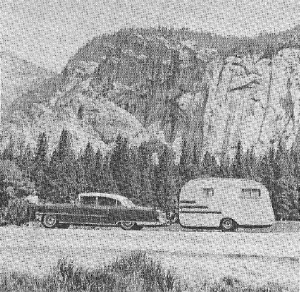
YOSEMITE – EDNA STANDING IN FRONT OF THE SPECIAL BUILT 8 FEET WIDE , 18 FEET LONG TRAILER
It was during a 1966 China Town dinner of the club that Ernie found out about ULTRA Vans. An attorney, Elwood Boles, told him about the new ULTRA Van. Ernie had been looking for a motorhome but they were all on truck chassis. He wanted something like his Scotman trailer, with a low center of gravity, twin beds and of course a both. The ULTRA Van was just what he and Edna had been looking for. Ernie contacted the factory in Hutchinson and made a deal to buy one. In the fall of 1966 he and Edna took the train to Kansas and picked up there new ULTRA Van #228. It was about the 12th unit produced in Hutchinson.
Their first night in their van was spent in a park near town. It was windy and rainy. With all of the wind and empty van, he was all over the road trying to steer it straight down the road (sound familiar?) Ernie’s thought’s at the time were, “what have I bought!”, but after a few days he learned how to steer the ULTRA Van (as we all have). After the rainy night in the park, it was back to fix the back window (sound familiar?) After that they started out for L.A. Going uphill and bucking the wind the engine was really pinging. Ernest knew this was not right so back he went to Hutchinson (50 miles). They sent him to the Buick garage that did all the adjustments of the engines. They set the timing back, (as we all know now) where it should be for the weight of the vehicles. So they set out again for L.A. Steering was the biggest thing to get used too, oversteering and passing (or being passed) by big trucks.
Ernest and Edna used their ULTRA Van and were still attending Vangard Travel Trailer Club events, but being the only motor home, he thought it would be nice to have a club of ULTRA Vans, where they would be a group with more in common. He contacted Larry Knipe, the ULTRA Van sales manager and got a list of West coast addresses of owners. Ernie sent out a mailing stating that he was going to be at the National meet of the International Travel and Trailer Clubs of America in Enumclaw, Washington. He would like to meet other ULTRA Van owners there with the thought of starting a club. Well, five ULTRA Van showed up and parked together causing quite a sensation. The Sandels were there with their 26 ft. van, the Maisons, the Dowell’s and the other names he wasn’t sure of. They decided to start a club and Ernest was appointed President protemp. He thought it best to incorporate in California in 1967. Elmor Worthy was the attorney who helped draw up the papers. He had done this for other trailer club in the country. Because he and Ernie were friends, there was no charge, only $18.00 to the State of California. Ernest thought there wouldn’t be anymore than maybe 25 members. Well, time has proved him wrong. The first rally was held at Knott’s Berry Farm in the fall of 1967. Seventeen ULTRA Van showed up and the ULTRA Van Club was on its way and rolling. Later on the name was changed to ULTRA Van Motor Coach Club, INC. and now has 240 members.
Ernie and Edna have been very happy with their ULTRA Van #603. The only thing he would change would be to add one foot in length to the shower area. So, it looks like David Peterson has done it again with a near perfect motor home layout. Their #603 (with over one hundred thousand miles) is featured with photos in this issue.
#603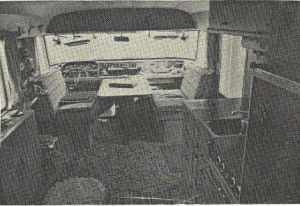
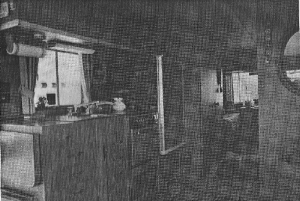
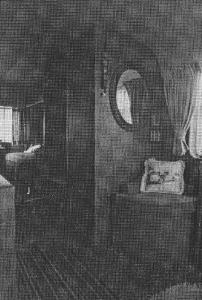
CHAIR THAT HIDES THE SIDE-MOUNTED ENGINE
Awards presented to the Newhouse’s
California Lutheran University – “Leadership Bronze Walnut Plaque” 1984
“Fellowship Award” 1961
ULTRA Club Special Gold Plated Plaque in 1970 for devoted service.
Silver Medal Plaque in 1953.
Northwestern School of Agriculture, University of Minnesota. “Top Aggie Award: for Past Achievement 1988
Ernie is listed in Who’s Who in the West, also in the Worlds Who’s Who (Commerce and Industry)
EDITOR’S NOTE
Ernie is special to me for I purchased his ULTRA Van #228 in January 1973. At that time he was taking delivery of his new ULTRA Van #603. This is the 24 foot unit built by David Peterson in Oakland, California, in 1971, with sidemounted V-8 engine. Five of these units were built. David Peterson has one (#601), the prototype (#602) went to Richard Nelson, Ernest Newhouse (#603), Phil Philips (#604) and the ULTRA Van shell built in the Sonoma factory belongs to George Truman (#605?) and he is outfitting it for travel.

